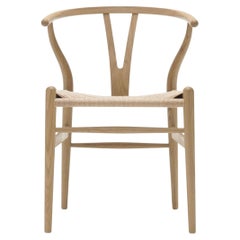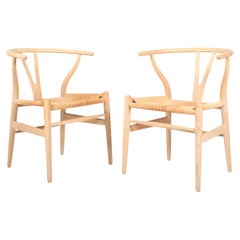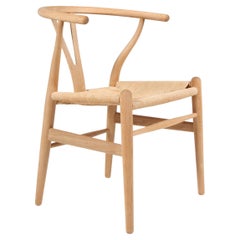Wishbone Chair Oak Soap
21st Century and Contemporary Danish Mid-Century Modern Dining Room Chairs
Papercord, Oak, Wood
Recent Sales
Vintage 1970s Danish Scandinavian Modern Chairs
Papercord, Oak
Vintage 1970s Danish Scandinavian Modern Chairs
Papercord, Oak
Vintage 1970s Danish Scandinavian Modern Chairs
Papercord, Oak
Mid-20th Century Danish Modern Dining Room Chairs
Oak, Papercord
Mid-20th Century Danish Scandinavian Modern Chairs
Oak
Mid-20th Century Danish Scandinavian Modern Chairs
Oak, Papercord
People Also Browsed
Mid-20th Century Italian Mid-Century Modern Wardrobes and Armoires
Walnut
Vintage 1950s Czech Art Deco Armchairs
Beech
Late 20th Century French Sofas
Leather
2010s American Mid-Century Modern Chandeliers and Pendants
Brass, Nickel
2010s Italian Chairs
Leather, Beech
2010s Italian Lounge Chairs
Textile
Late 20th Century Danish Scandinavian Modern Table Lamps
Ceramic, Stoneware
2010s American Organic Modern Coffee and Cocktail Tables
Hardwood, Walnut
21st Century and Contemporary Italian Modern Night Stands
Brass
Vintage 1920s French Art Deco Chandeliers and Pendants
Brass
Vintage 1970s French Modern Sofas
Leather
Vintage 1960s Italian Mid-Century Modern Coffee and Cocktail Tables
Plywood
2010s Decorative Art
Ceramic
Vintage 1960s Italian Vases
Glass
2010s Mexican Mid-Century Modern Floor Lamps
Organic Material, Hardwood
2010s Mexican Organic Modern Sideboards
Hardwood, Walnut
Wishbone Chair Oak Soap For Sale on 1stDibs
How Much is a Wishbone Chair Oak Soap?
Carl Hansen & Søn for sale on 1stDibs
Family-owned since its inception, Carl Hansen & Søn has been one of the most prestigious furniture manufacturers in Denmark for more than a century. The firm has produced timeless masterpieces of Scandinavian modernism by iconic designers Hans Wegner, Arne Jacobsen, Børge Mogensen and others.
In 1908, cabinetmaker Carl Hansen opened his first small workshop near Odense, Denmark, where he created furniture by hand in the preferred Victorian style of the times. Hansen expanded his operations by 1915 due to high demand. The larger factory allowed room for more modern machinery and a staff of many journeymen who produced a small series of their most popular pieces, including coffee tables, cabinets and sculptural, inviting armchairs. The firm became known for marrying the finest handmade craftsmanship with efficient production processes.
The Great Depression of the 1930s saw worldwide furniture sales plummet, and many furniture manufacturers were forced to shutter their workshops. At the age of 23, furniture maker Carl Hansen’s youngest son, Holger, took control of his father’s factory and piloted it through the era’s uncertain waters.
Holger Hansen’s youthful enthusiasm, innovative spirit, and intuitive business savvy kept their company afloat. He believed in the quality of the firm’s work and the cutting-edge designs that were produced at its factory, which emerged from modest beginnings to become a pivotal piece of the history of Danish furniture.
Owing to Holger’s leadership, Carl Hansen & Søn emerged from the Great Depression and entered into creative alliances with many acclaimed Danish masters of mid-century design, including Kaare Klint, Børge Mogensen, Arne Jacobsen, Ole Wanscher, Frits Henningsen and Poul Kjærholm.
None of these partnerships proved as prolific as their relationship with Hans Wegner, however. In 1949, the cabinetmaker moved to Denmark’s Funen Island and was staying in Holger’s family home, as the then-Carl Hansen CEO had commissioned Wegner to create a chair for the company that was similar to his popular China chair of 1944.
Wegner began to work closely with the company’s craftsmen and devised a streamlined chair with a Y-shaped back and woven paper-cord seat. The legendary Wishbone chair, which still involves nearly 100 processes and takes weeks to make, has been in continuous production since its 1950 debut.
Carl Hansen & Søn has manufactured some of the most extraordinary chairs, sofas and lounge chairs for living room relaxation in the history of design. Their dining room tables and chairs run the gamut in style and functionality, from everyday comfort to elegant entertaining. The company’s impressive roster of contemporary designers includes renowned Japanese architect Tadao Ando, the Vienna-based design firm EOOS and celebrated American industrial designer Brad Ascalon. They remain the world’s largest producer of Wegner’s furniture and still enjoy a collaborative relationship with the Hans J. Wegner Studio.
On 1stDibs, find vintage Carl Hansen & Søn chairs, tables, case pieces and other furniture.
Finding the Right Chairs for You
Chairs are an indispensable component of your home and office. Can you imagine your life without the vintage, new or antique chairs you love?
With the exception of rocking chairs, the majority of the seating in our homes today — Windsor chairs, chaise longues, wingback chairs — originated in either England or France. Art Nouveau chairs, the style of which also originated in those regions, embraced the inherent magnificence of the natural world with decorative flourishes and refined designs that blended both curved and geometric contour lines. While craftsmanship and styles have evolved in the past century, chairs have had a singular significance in our lives, no matter what your favorite chair looks like.
“The chair is the piece of furniture that is closest to human beings,” said Hans Wegner. The revered Danish cabinetmaker and furniture designer was prolific, having designed nearly 500 chairs over the course of his lifetime. His beloved designs include the Wishbone chair, the wingback Papa Bear chair and many more.
Other designers of Scandinavian modernist chairs introduced new dynamics to this staple with sculptural flowing lines, curvaceous shapes and efficient functionality. The Paimio armchair, Swan chair and Panton chair are vintage works of Finnish and Danish seating that left an indelible mark on the history of good furniture design.
“What works good is better than what looks good, because what works good lasts,” said Ray Eames.
Visionary polymaths Ray and Charles Eames experimented with bent plywood and fiberglass with the goal of producing affordable furniture for a mass market. Like other celebrated mid-century modern furniture designers of elegant low-profile furnishings — among them Ludwig Mies van der Rohe and Finn Juhl — the Eameses considered ergonomic support, durability and cost, all of which should be top of mind when shopping for the perfect chair. The mid-century years yielded many popular chairs.
The Eameses introduced numerous icons for manufacturer Herman Miller, such as the Eames lounge chair and ottoman, molded plywood dining chairs the DCM and DCW (which can be artfully mismatched around your dining table) and a wealth of other treasured pieces for the home and office.
A good chair anchors us to a place and can become an object of timeless appeal. Take a seat and browse the rich variety of vintage, new and antique chairs on 1stDibs today.
Read More
The 21 Most Popular Mid-Century Modern Chairs
You know the designs, now get the stories about how they came to be.
Design Icon Ilse Crawford on Her Colorful New Hans Wegner Chairs
If anyone is brave, humble and adept enough to recolor these mid-century masterpieces, it’s Ilse Crawford. Here, she gives us the details on her five earthy paint choices and tells us how she feels about design collaborations.


